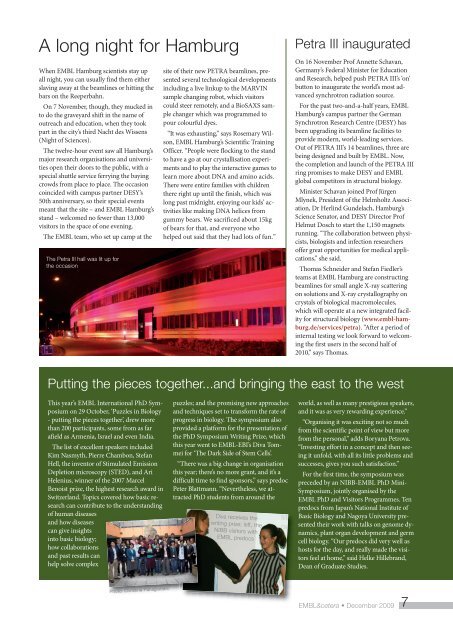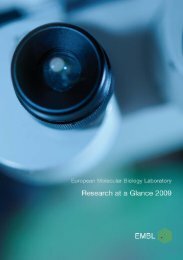Bernd-Uwe retires - EMBL Grenoble
Bernd-Uwe retires - EMBL Grenoble
Bernd-Uwe retires - EMBL Grenoble
You also want an ePaper? Increase the reach of your titles
YUMPU automatically turns print PDFs into web optimized ePapers that Google loves.
A long night for HamburgWhen <strong>EMBL</strong> Hamburg scientists stay upall night, you can usually find them eitherslaving away at the beamlines or hitting thebars on the Reeperbahn.On 7 November, though, they mucked into do the graveyard shift in the name ofoutreach and education, when they tookpart in the city’s third Nacht des Wissens(Night of Sciences).The twelve-hour event saw all Hamburg’smajor research organisations and universitiesopen their doors to the public, with aspecial shuttle service ferrying the bayingcrowds from place to place. The occasioncoincided with campus partner DESY’s50th anniversary, so their special eventsmeant that the site – and <strong>EMBL</strong> Hamburg’sstand – welcomed no fewer than 13,000visitors in the space of one evening.The <strong>EMBL</strong> team, who set up camp at theThe Petra III hall was lit up forthe occasionsite of their new PETRA beamlines, presentedseveral technological developmentsincluding a live linkup to the MARVINsample changing robot, which visitorscould steer remotely, and a BioSAXS samplechanger which was programmed topour colourful dyes.“It was exhausting,” says Rosemary Wilson,<strong>EMBL</strong> Hamburg’s Scientific TrainingOfficer. “People were flocking to the standto have a go at our crystallisation experimentsand to play the interactive games tolearn more about DNA and amino acids.There were entire families with childrenthere right up until the finish, which waslong past midnight, enjoying our kids’ activitieslike making DNA helices fromgummy bears. We sacrificed about 15kgof bears for that, and everyone whohelped out said that they had lots of fun.”Petra III inauguratedOn 16 November Prof Annette Schavan,Germany’s Federal Minister for Educationand Research, helped push PETRA III’s ‘on’button to inaugurate the world’s most advancedsynchrotron radiation source.For the past two-and-a-half years, <strong>EMBL</strong>Hamburg’s campus partner the GermanSynchrotron Research Centre (DESY) hasbeen upgrading its beamline facilities toprovide modern, world-leading services.Out of PETRA III’s 14 beamlines, three arebeing designed and built by <strong>EMBL</strong>. Now,the completion and launch of the PETRA IIIring promises to make DESY and <strong>EMBL</strong>global competitors in structural biology.Minister Schavan joined Prof JürgenMlynek, President of the Helmholtz Association,Dr Herlind Gundelach, Hamburg’sScience Senator, and DESY Director ProfHelmut Dosch to start the 1,150 magnetsrunning. “The collaboration between physicists,biologists and infection researchersoffer great opportunities for medical applications,”she said.Thomas Schneider and Stefan Fiedler’steams at <strong>EMBL</strong> Hamburg are constructingbeamlines for small angle X-ray scatteringon solutions and X-ray crystallography oncrystals of biological macromolecules,which will operate at a new integrated facilityfor structural biology (www.embl-hamburg.de/services/petra).“After a period ofinternal testing we look forward to welcomingthe first users in the second half of2010,” says Thomas.Putting the pieces together...and bringing the east to the westThis year’s <strong>EMBL</strong> International PhD Symposiumon 29 October, ‘Puzzles in Biology- putting the pieces together’, drew morethan 200 participants, some from as farafield as Armenia, Israel and even India.The list of excellent speakers includedKim Nasmyth, Pierre Chambon, StefanHell, the inventor of Stimulated EmissionDepletion microscopy (STED), and AriHelenius, winner of the 2007 MarcelBenoist prize, the highest research award inSwitzerland. Topics covered how basic researchcan contribute to the understandingof human diseasesand how diseasescan give insightsinto basic biology;how collaborationsand past results canhelp solve complexpuzzles; and the promising new approachesand techniques set to transform the rate ofprogress in biology. The symposium alsoprovided a platform for the presentation ofthe PhD Symposium Writing Prize, whichthis year went to <strong>EMBL</strong>-EBI’s Diva Tommeifor ‘The Dark Side of Stem Cells’.“There was a big change in organisationthis year; there’s no more grant, and it’s adifficult time to find sponsors,” says predocPeter Blattmann. “Nevertheless, we attractedPhD students from around theDiva receives thewriting prize; left, theNIBB visitors with<strong>EMBL</strong> predocsworld, as well as many prestigious speakers,and it was as very rewarding experience.”“Organising it was exciting not so muchfrom the scientific point of view but morefrom the personal,” adds Boryana Petrova.“Investing effort in a concept and then seeingit unfold, with all its little problems andsuccesses, gives you such satisfaction.”For the first time, the symposium waspreceded by an NIBB-<strong>EMBL</strong> PhD Mini-Symposium, jointly organised by the<strong>EMBL</strong> PhD and Visitors Programmes. Tenpredocs from Japan’s National Institute ofBasic Biology and Nagoya University presentedtheir work with talks on genome dynamics,plant organ development and germcell biology. “Our predocs did very well ashosts for the day, and really made the visitorsfeel at home,” said Helke Hillebrand,Dean of Graduate Studies.Photo: Christine Panagiotidis<strong>EMBL</strong>&cetera • December 2009 7













